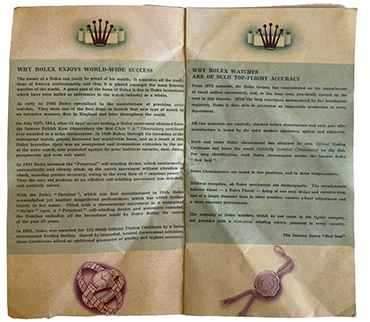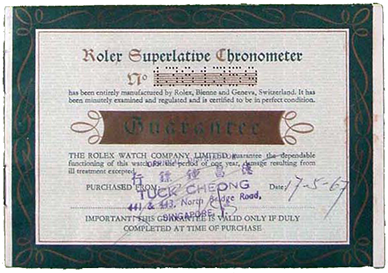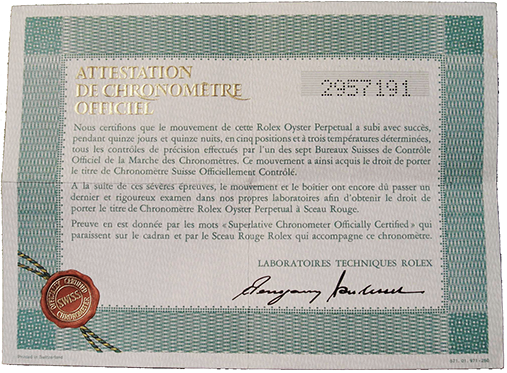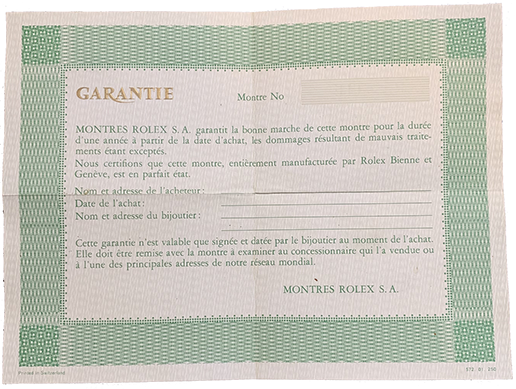


-crop-u13342.jpg?crc=228779449)
Rolex produced a variety of "Garantie" papers throughout the decades, also known as "Guarantee" papers or simply as "Papers." Many collectors like to have the original papers that accompanied the watch at the time of purchase along with whatever bits and pieces that may have come with the watch.
Full sets, as they are sometimes called, are miniature time capsules from eras gone by. They are much rarer than loose watches because paperwork and accessories tended to get lost or separated through moves and changes in ownership. Rolex Sport watches were considered utilitarian and the accompanying ephemera was considered superfluous. It was commonly discarded at the time of purchase, often before leaving the retail establishment.
Most Rolex print material has control codes at the bottom of the last page that include the quantity of the run and the year of production which were very useful in creating the following compendium of the Papers that would have accompanied watches from the 1950s to the early 1990s. However, it's Important to keep in mind that Rolex Authorized Dealers in different geographic regions may not have used the same Papers concurrently and watches were sold years after their manufacture, depending local markets. Therefore, all dates herein are all approximations based on date codes and anecdotal information.

1950-1955
1950-1955
In the early 1950s the Guarantee document came in a fancifully printed booklet form, consisting of eight 4"x71/4" stapled pages. The date of purchase and case number were typed or handwritten by the Authorized Dealer or "AD" at the time of sale.
1955-1966



Rolex introduced a much smaller 3-7/8"x2-5/8" "Green Foldout" design in 1955. These foldout booklets were produced for over a decade in a variety of languages, including, English, French, Italian, Spanish, German and Portuguese. The date code and the "Rolex Roll of Honour" on the back page was updated annually.

Chronometer rated watches were also accompanied by the Bureaux Suisses
certificates as and the Red Seal hang tag.
1960-1966
In 1960, Rolex created a new design for use specifically with "Superlative Chronometer" watches. It was larger and more fancifully printed. It measured 5.125" x 3.75", and consisted of eight staple bound pages. These booklets were also translated into other languages.



GMT Master ref. 1675 Full Set circa 1963.
Circa 1965 Rolex started using perforating machines to punch holes in the Chronometer Certiicates as well as the Guarantee Booklets. These were the first papers that were "Double Punched."
1960-1970 (UK)


Region-specific Guarantee Papers were also produced for various markets. For example, in the UK, a 36-page booklet was printed in England throughout the 1960s and early 1970s with small variations. The booklet featured the Bexley Rolex Service Center and a Guarantee page to be completed at the dealer inside the cover.
This is a less common variant of the "Rolex Superlative Chronometer" booklet from 1966. It has the same number of pages and is also the same size.




1967-68





In 1967, Rolex introduced a 36 page "Guarantee Booklet" that included an 8-panel fold-out form in the center. Per the cover title, this booklet was intended to accompany "Your Rolex Oyster," which applied to all Rolex Sport models except the Daytona references 6239/6241, which did not have an Oyster case at the time. The booklet was mostly used for Chronometer rated watches that were also accompanied by the Bureaux Suisses certificates and the Red Seal hang tag. Most but not all the booklets were punched with a perforating machine as well as the Chronometer certificates.
1967-1972





Around the same time as the introduction of the Guarantee Booklet, Rolex eliminated the Green Foldouts and introduced another smaller booklet consisting of 8-pages. It was clearly intended for use with non-Oyster models such as the Daytona 6239/6241. It was usually completed by hand or typewriter. Although in some instances the case number of the watch was embossed, or even punched, depending on the equipment available to the dealer at the time. Althoug it has an Oyster case, this booklet was commonly used with the Submariner 5513. This booklet was produced with very minor text revisions over the years until its final version was printed in 1972.
1968-69



Rolex updated the Oyster Guarantee booklet in 1968 with some text changes and revised the cover and centerfold artwork. The new design also eliminated the foldout panels of the centerfold.

1970



An update to the Oyster Guarantee booklet was incorporated around 1970 wherein the centerfold pages were eliminated altogether and the Guarantee was reduced to a single page in the back of the booklet.




Rolex eliminated the use of the Bureaux Suisses Chronometer certificates around this time and replaced them with its own design. They were beautifully printed and produced by Rolex which was more efficient and economical.
1971-1974



Rolex removed the personalized Guarantee and watch specific information page from the back of the booklet.
The cover was also updated and "Oyster" was removed from the cover.

The Chronometer certificate was enlarged to accommodate the "Garantie" section that was added to the top of the page with room for owner and dealer information. A smaller certificate, without the Red Seal, was also introduced for use with non-Chronometer watches.




Rolex and Crown logo watermarks were added throughout the Papers to thwart unauthorized duplication.
1975-2002


The Chronometer and Garantie papers were updated with a crown border, a design that remained largely unchanged until 2005.
RolexHaven.com is intended for informational purposes only and is in no way sponsored, endorsed,
or affiliated with Rolex U.S.A., Rolex S.A. or any other Rolex worldwide subsidiary. © All Rights Reserved 2020